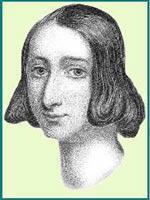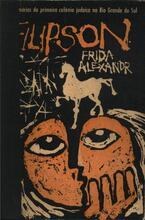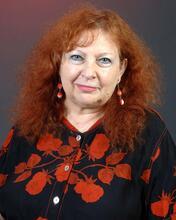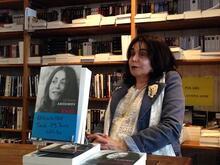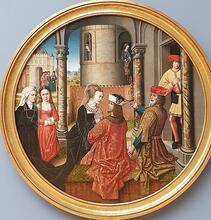Miriam Raskin
Miriam Raskin, born in White Russia in 1889, wrote vivid accounts of young Jewish women’s lives within a revolutionary movement. After participating in the 1905 Russian Revolution and serving a year in a St. Petersburg prison, Raskin immigrated to the United States in 1920 and began writing. She published three books, a serialized novel, and numerous short stories in various periodicals, most notably in the literary journal <i>Di Tsunkunft</i>. Raskin has been praised for her vibrant and wide-ranging writing style. She was able to reveal the stories of unsung heroes and focus on the impact of ordinary people are revolutionary movements.
Miriam Raskin’s special talent lay in her depictions of ordinary working people. She was able to write about individuals not usually considered especially noteworthy, and make them interesting. In addition, her work often features strong female protagonists.
Biographical details about Miriam Raskin are sketchy. She was born in Slonim, White Russia in 1889. At an early age, she joined the Bund, participated in the 1905 revolution, served a year in a St. Petersburg prison, and arrived in New York in 1920.
Literary Career
Raskin published three books, a serialized novel, and numerous short stories in various periodicals, most notably in the literary journal Di Tsunkunft. A short tribute to Abraham Liessin (1872–1936), the editor of Di Tsunkunft, which she wrote on the occasion of his death, appeared in the March 1936 issue. Like many of her well-known contemporaries, Raskin also wrote stories for Kinderzhournal, a children’s magazine edited for many years by the noted Yiddish literary critic Shmuel Niger. In addition, her short story, A matone der mamen, was published in a third-grade reader for children edited by Zalman Yefroykin.
Tsen yor lebn is the earliest of Raskin’s works discovered so far; it was published in 1927 by Farlag Frayhayt. Raskin published two other books—an anthology of short stories entitled Shtile lebns, published in 1941 in New York by “a group of friends,” and Zlatke, a novel published in 1951 by Farlag Unzer Tsayt. Another novel, Bay a fremdn fayer, was serialized in the major Yiddish newspaper Der Forverts (The Jewish Daily Forward) in 1951.
Literary Themes
Raskin’s two novels published as books focus on the same theme, yet are written in different forms. Clearly based to some extent on Raskin’s own early life, they both provide us with a vivid, insider’s view of life within a revolutionary movement. The stories are recounted from the perspective of a young woman, born and raised in a traditional Jewish household, who defies convention and leaves home at an early age to join “the movement.” Tsen yor lebn, the earlier book, is written as a fictionalized diary, while Zlatke, published twenty-four years later, is written as a novel and is nearly twice as long. It should be noted that in both cases the main character is not a movement leader, but simply one of the rank and file, and this is very much in keeping with Raskin’s focus on ordinary people.
Many of Raskin’s short stories, which depict Jewish life in America, are peppered with English words transliterated into Yiddish either as is (e.g. “policeman,” “school,” “college”) or as Yiddish-accented English (e.g. “bordvok,” “ayz-crim”). In fact, one of her short stories, published in the April 1931 issue of Di Tsukunft, is entitled “Der dishvasher.” However, this seemingly casual use of English words does not appear in the two above-mentioned novels, which take place in Czarist Russia. In the case of Tsen yor lebn, one could assume that the author had simply not been in America long enough for English to become part of her overall linguistic universe; however, when one notes the lack of English words in Zlatke, published after she had lived in New York for thirty-one years, it becomes clear that Raskin was indeed aware of linguistic idiom and that she used words deliberately, not casually.
No further information or critical literature regarding Tsen yor lebn has been found thus far, but her two later books were reviewed extensively in the Yiddish press, both in America and abroad. Her work was considered significant enough to be reviewed by such notable figures as Shmuel Niger and Forverts editor Abraham Cahan. In fact, Cahan’s lengthy review of Raskin’s short story anthology in the December 21, 1941 edition of Der forverts spanned five columns and included a photograph of Raskin.
Significance
Many reviewers of Raskin’s work mention that she “paints” pictures of her characters’ lives. Her writing style is fairly simple and easy to read, yet her “pictures” are extremely vibrant, and resemble photographs rather than paintings. Her “photo album” is wide-ranging—children finding ways to earn money, a clandestine meeting of a revolutionary cell, a street demonstration that becomes violent, a young woman from a traditional background passing out contraband literature and getting arrested, and so on.
In Raskin’s work, the reader will discover the stories of unsung heroes—as Raskin herself states in her introduction to Zlatke, “…those heroes whose names will not be recorded in history.”
Miriam Raskin died on October 18, 1973.
Selected Works by Miriam Raskin
Tsen yor lebn: di finfte yorn. Farlag Freiheit. New York: Frayhayt, 1927.
Shtile lebns. Published by “a group of friends.” New York: 1941.
Zlatke. Farlag Undzer Tsayt. New York: Unzer tsayt, 1951.
Ten short stories in Di Tsukunft between 1931 and 1938.
Di Koyekh fun perzenlekhkayt in Di Tsukunft, March 1936.
A matone der mamen in Z. Yefroikin, Dos lebedike velt; leyenbukh far dos dritn lernyor (The Living World: Third Grade Workbook). New York: Bildungs-comitet fun arbeter-ring (Educational Department of the Workmen’s Circle), 1954, 79–83.
Nine short stories in Kinderzhournal between 1936 and 1940.
Bay a fremdn fayer, serialized in Der Forverts, 1951.
Leksikon fun der nayer yiddisher literatur. Congress for Jewish Culture. New York: 1981.
Forman, Frieda et al. (eds.), Found Treasures: Stories by Yiddish Women Writers. Toronto: 1994.
Selected Book Reviews of Raskin’s Second and Third Books
Cahan, A. “A band ertseylungen fun Miriam Raskin.” Der Forverts, December 21, 1941.
Kharlash, Y. “Mit Zlatke’s oygen.” Di Tsukunft 57/4 (April 1952): 195.
Niger, Shmuel. “Kleyn leben un groys leben.” Der Tog, March 21, 1943.
Idem. “Der held iz—a dor.” Der Tog, March 2, 1952.
Zinger, Sh. D. “Tsvey bikher dertseylungen.” Di Tsunkunft 47/7 (August 1942): 504.






